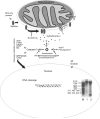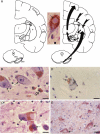Biology of mitochondria in neurodegenerative diseases
- PMID: 22482456
- PMCID: PMC3530202
- DOI: 10.1016/B978-0-12-385883-2.00005-9
Biology of mitochondria in neurodegenerative diseases
Abstract
Alzheimer's disease (AD), Parkinson's disease (PD), and amyotrophic lateral sclerosis (ALS) are the most common human adult-onset neurodegenerative diseases. They are characterized by prominent age-related neurodegeneration in selectively vulnerable neural systems. Some forms of AD, PD, and ALS are inherited, and genes causing these diseases have been identified. Nevertheless, the mechanisms of the neuronal degeneration in these familial diseases, and in the more common idiopathic (sporadic) diseases, are unresolved. Genetic, biochemical, and morphological analyses of human AD, PD, and ALS, as well as their cell and animal models, reveal that mitochondria could have roles in this neurodegeneration. The varied functions and properties of mitochondria might render subsets of selectively vulnerable neurons intrinsically susceptible to cellular aging and stress and the overlying genetic variations. In AD, alterations in enzymes involved in oxidative phosphorylation, oxidative damage, and mitochondrial binding of Aβ and amyloid precursor protein have been reported. In PD, mutations in mitochondrial proteins have been identified and mitochondrial DNA mutations have been found in neurons in the substantia nigra. In ALS, changes occur in mitochondrial respiratory chain enzymes and mitochondrial programmed cell death proteins. Transgenic mouse models of human neurodegenerative disease are beginning to reveal possible principles governing the biology of selective neuronal vulnerability that implicate mitochondria and the mitochondrial permeability transition pore. This chapter reviews several aspects of mitochondrial biology and how mitochondrial pathobiology might contribute to the mechanisms of neurodegeneration in AD, PD, and ALS.
Copyright © 2012 Elsevier Inc. All rights reserved.
Figures






Similar articles
-
Mitochondrial and Cell Death Mechanisms in Neurodegenerative Diseases.Pharmaceuticals (Basel). 2010;3(4):839-915. doi: 10.3390/ph3040839. Pharmaceuticals (Basel). 2010. PMID: 21258649 Free PMC article.
-
Mitochondrial pathobiology in Parkinson's disease and amyotrophic lateral sclerosis.J Alzheimers Dis. 2010;20 Suppl 2:S335-56. doi: 10.3233/JAD-2010-100348. J Alzheimers Dis. 2010. PMID: 20413846 Review.
-
Mitochondrial pathobiology in ALS.J Bioenerg Biomembr. 2011 Dec;43(6):569-79. doi: 10.1007/s10863-011-9395-y. J Bioenerg Biomembr. 2011. PMID: 22083126 Free PMC article. Review.
-
Mitochondriopathy in Parkinson disease and amyotrophic lateral sclerosis.J Neuropathol Exp Neurol. 2006 Dec;65(12):1103-10. doi: 10.1097/01.jnen.0000248541.05552.c4. J Neuropathol Exp Neurol. 2006. PMID: 17146283 Review.
-
Oxidative stress, mitochondrial dysfunction and cellular stress response in Friedreich's ataxia.J Neurol Sci. 2005 Jun 15;233(1-2):145-62. doi: 10.1016/j.jns.2005.03.012. J Neurol Sci. 2005. PMID: 15896810 Review.
Cited by
-
Molecular strategies for targeting antioxidants to mitochondria: therapeutic implications.Antioxid Redox Signal. 2015 Mar 10;22(8):686-729. doi: 10.1089/ars.2014.5952. Antioxid Redox Signal. 2015. PMID: 25546574 Free PMC article. Review.
-
Mitochondrial and Oxidative Stress Aspects in Hippocampus of Rats Submitted to Dietary n-3 Polyunsaturated Fatty Acid Deficiency After Exposure to Early Stress.Neurochem Res. 2015 Sep;40(9):1870-81. doi: 10.1007/s11064-015-1679-x. Epub 2015 Aug 1. Neurochem Res. 2015. PMID: 26232249
-
Effects of Ageing on the Mitochondrial Genome in Rat Vestibular Organs.Curr Aging Sci. 2018;11(2):108-117. doi: 10.2174/1874609811666180830143358. Curr Aging Sci. 2018. PMID: 30777575 Free PMC article.
-
Mitochondrial Stress Response in Neural Stem Cells Exposed to Electronic Cigarettes.iScience. 2019 Jun 28;16:250-269. doi: 10.1016/j.isci.2019.05.034. Epub 2019 May 28. iScience. 2019. PMID: 31200115 Free PMC article.
-
Gene expression profiling for human iPS-derived motor neurons from sporadic ALS patients reveals a strong association between mitochondrial functions and neurodegeneration.Front Cell Neurosci. 2015 Aug 4;9:289. doi: 10.3389/fncel.2015.00289. eCollection 2015. Front Cell Neurosci. 2015. PMID: 26300727 Free PMC article.
References
-
- Zorov DB, Isave NK, Plotnikov EY, Zorova LD, Stelmashook EV, Vasileva AK, et al. The mitochondrion as Janus Bifrons. Biochemistry (Mosc) 2007;72:1115–26. - PubMed
-
- Halliwell B. Role of free radicals in the neurodegenerative diseases. Drugs Aging. 2001;18:685–716. - PubMed
-
- Nicholls DG. Mitochondrial function and dysfunction in the cell: its relevance to aging and aging-related disease. Int J Biochem Cell Biol. 2002;34:1372–81. - PubMed
-
- Fridovich I. Superoxide radical and superoxide dismutases. Annu Rev Biochem. 1995;64:97–112. - PubMed
Publication types
MeSH terms
Substances
Grants and funding
LinkOut - more resources
Full Text Sources
Other Literature Sources
Medical
Miscellaneous

